Featured designers and producers
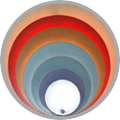 |
 |
 |
 |
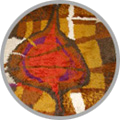 |
 |
|
| Lyfa | Torben Ørskov | Louis Weisdorf | Simon Henningsen | Ege Rya | Jo Hammerborg | Fog & Mørup |
Ege Rya is a subsidiary of Denmark's largest and most prestigious carpet manufacturer Ege Taepper. Based at Herning in Jutland, Ege Taepper was set up in 1938 by Mads Eg Damgaard, and the company flourished during the 1940s despite the shortages of raw materials associated with the second world war by introducing products made from alternative materials such as paper-based fabrics. The company's expansion continued through the following decades and today, in addition to the parent company in Herning, there are Ege companies in the UK, Germany, France, Norway and Sweden, and Ege distributors around the world.
The Ege Rya subsidiary became Denmark’s most successful rug producer in the 1960s, 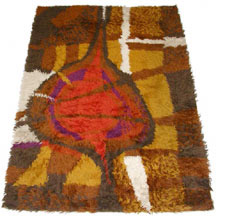 a position it acquired and held throughout that decade thanks in no small part to an advertising campaign that created a surreal Ege Rya world in which the rugs were presented as part of the outdoor landscape. The series began in 1962 with a bride stepping from her wedding coach onto an Ege Rya conveniently placed on the muddy lane below (evidently indicating that the rugs would make an ideal wedding gift) and took on an increasingly offbeat and bizarre character as the 1960s progressed. Both rugs and locations embraced the psychedelic space age aesthetic as bold patterns and colours were introduced into the rugs and futuristic-looking models posed in lunar-like landscapes, culminating in a return to a more Nordic-looking environment with the introduction of the Ege Rya de Luxe range in 1970.
a position it acquired and held throughout that decade thanks in no small part to an advertising campaign that created a surreal Ege Rya world in which the rugs were presented as part of the outdoor landscape. The series began in 1962 with a bride stepping from her wedding coach onto an Ege Rya conveniently placed on the muddy lane below (evidently indicating that the rugs would make an ideal wedding gift) and took on an increasingly offbeat and bizarre character as the 1960s progressed. Both rugs and locations embraced the psychedelic space age aesthetic as bold patterns and colours were introduced into the rugs and futuristic-looking models posed in lunar-like landscapes, culminating in a return to a more Nordic-looking environment with the introduction of the Ege Rya de Luxe range in 1970.
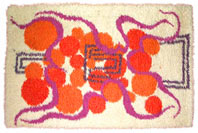
In his 1961 publication Scandinavian Design, Ulf Hård af Segerstad outlines the history of the rya rug. Dating from the 15th century, he explains, the first Scandinavian ryas were coarse, long-piled, heavy covers used by seal hunters and deep-sea fishermen instead of furs. Later the rugs became lighter and more ornamental, and in the 19th century were often splendid festive tapestries regarded as valuable articles of inheritance. By the mid-20th century the rya had become a sort of painting in textiles, says Segerstad, with the individual artist identifiable by the colours, patterns and techniques in much the same way that one identifies a painter's canvas.
The rya bears witness, he concludes, like few other Scandinavian handicraft products, to a culture in which 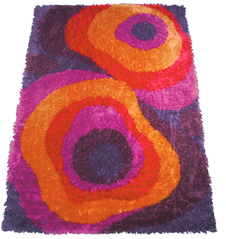 the cosy indoor warmth is a vitally important complement to an often severe climate. And still today, ryas are often displayed on a wall during the warmer summer months and taken down for use on the floor or even the bed during the cold Scandinavian winters.
the cosy indoor warmth is a vitally important complement to an often severe climate. And still today, ryas are often displayed on a wall during the warmer summer months and taken down for use on the floor or even the bed during the cold Scandinavian winters.
It is the artistic nature of the design together with the deep and dense shag pile that characterises the mid to late 20th century rya. Ege's striking ryas of the 1960s and 1970s were machine-made to very high standards of quality in 100 per cent pure wool with a 2.5cm pile, with mothproofing and colourproofing to ensure that the rugs would have a long lifespan, and a 25-year guarantee to that effect. Their quality is reflected in the fact that some 10 to 15 years after the guarantee period a high proportion were still bright and intact.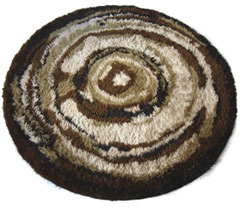
The standard size of a 60s Ege rya was 140 x 200cm, as illustrated above in a design entitled Sunrise and (top) in a midcentury-modern style of artwork entitled Savannah. A smaller Ege rya size was 70 x 110cm, as pictured above right in an example from Ege's Boutique range in a design called Abstracta, and there was also a less common supersize 250 x 360cm. Much less common again, and confined to the Ege de Luxe range, were the circular ryas with a diameter of 200cm (see right), and rarest of all were the magnificent and elusive 250cm diameter Ege de Luxe circular ryas.
© 2004 Classic Modern. All rights reserved.
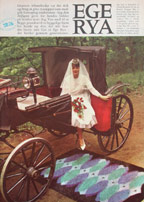 |
 |
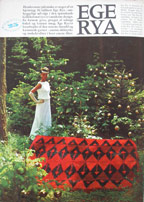 |
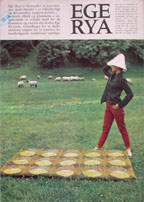 |
 |
 |
 |
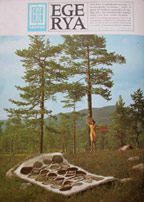 |
 |
 |
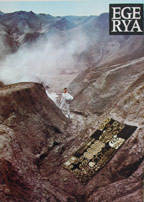 |
 |
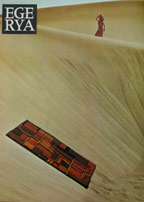 |
 |
 |
 |
 |
 |
 |
 |
 |
 |
 |
 |
 |
 |
|
| Lyfa | Torben Ørskov | Louis Weisdorf | Simon Henningsen | Ege Rya | Jo Hammerborg | Fog & Mørup |